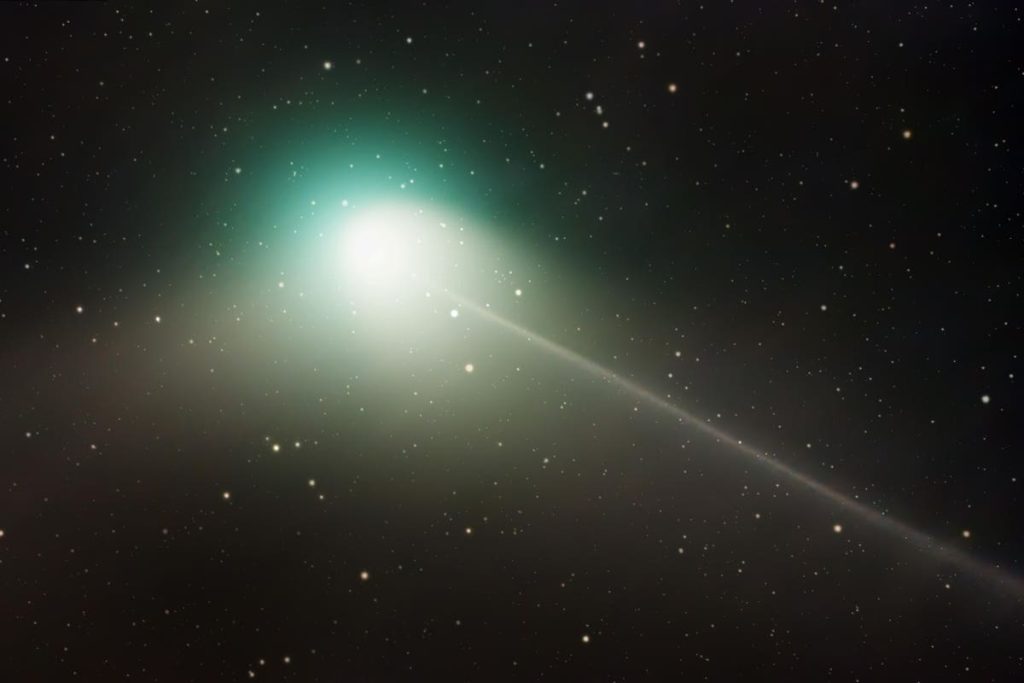Asteroids are frequently targeted as civilization killers. But long period comets that approach Earth from high orbital inclinations have historically blindsided our planet as impactors. Mercifully, such cometary interlopers appear to be infrequent. Yet only in the last few decades have astronomers had the tools to fully characterize such comets.
Thus, Comet C/2022 E3 (ZTF), which famously made headlines early last year and others like it, can provide crucial details in understanding and potentially mitigating rare civilization-ending comet impactors.
First discovered at Palomar Observatory in March of 2022, ZTF was immediately noted for its green hue due to its carbon dominated gas coma.
We discovered C/2022 E3 (ZTF) about a year before its closest approach with Earth, Bryce Bolin, the lead author of a new paper appearing in the journal The Monthly Notices of the Royal Astronomical Society, told me by phone. ZTF is on a hyperbolic trajectory and will leave the solar system and become an interstellar object, Bolin, a planetary astronomer, and postdoctoral researcher at NASA Goddard Space Flight Center, told me.
ZTF’s closest approach was about 100 times the distance from Earth to the Moon.
It likely formed in the region of the planets Saturn and Uranus and then after passing too close to either of these planets was tossed out to the Oort Cloud, Lowell Observatory astronomer David Schleicher, who was not a co-author on the paper, told me via email.
All of today’s comets are fragments of what were once planetesimals billions of years ago in the protoplanetary disk, Yan Fernandez, a University of Central Florida astronomer who was not a co-author, told me via email. Most of the planetesimals got incorporated into planets or got flung out of the Solar System entirely, he says. A few were thrown into the Oort Cloud, and comet ZTF is presumably one of those, Fernandez says.
But interactions with galactic tides and encounters with passing stars can cause these scattered comets to be forced back into the inner solar system, Bolin and colleagues note in their paper.
Why Should We Worry About Such Comets?
There are trillions of comets ‘stored’ in the Oort Cloud, all much too faint to detect from Earth, says Schleicher. Only when their orbits are perturbed, causing some of them to make their way into the inner Solar System, do they potentially become a danger to us, he says.
Canada’s Sudbury Basin in Ontario is one of the best examples of the destruction caused by an ancient high-inclination cometary impactor. Initially thought to be an asteroid and later interpreted as a comet, the object responsible for creating the Sudbury Basin crashed into Earth about 1.8 billion years ago, says NASA. The impact was so devastating that it resulted in a crater that stretched some 200 km across and actually punctured Earth’s crust, NASA notes.
ZTF came into the inner solar system on a trajectory that was almost perpendicular to the plane of the solar system. That’s one reason why Oort Cloud Comets are potentially so dangerous.
It’s important that we look for comets in regions of the sky towards the Sun or at high latitudes, says Bolin. From these locations, objects on high inclinations can be hidden in plain sight, he says.
If we spotted a high inclination comet on a collision course with Earth, how could we deflect it?
Mitigation procedures would be severely restricted with current observatories due to the likely short time interval between discovery and encounter with Earth, says Bolin. Future observatories such as the NEO Surveyor Mission and Rubin Observatory may be able to detect these objects with enough advance warning to employ mitigation procedures, he says.
The latter observatory, says Schleicher, is expected to image the entire night sky every 6 nights and will begin operations in 2024.
Comets Speed Up As They Approach The Sun
Comets strike the Earth with 4 to 10 times more kinetic energy than asteroids. So, if they hit, this makes comets much more destructive than asteroids.
The key for deflection is how much warning one gets, since the farther away an object is when you alter the course, the less energy it takes to miss Earth, says Schleicher.
As for any good news?
We now live in an era where we have the means to detect potentially Earth-crossing comets from farther afield.
While most never actually cross Earth’s orbit, comets like ZTF come very close, says Schleicher. So, it’s useful to determine just how often they come this close, he says.
Read the full article here










